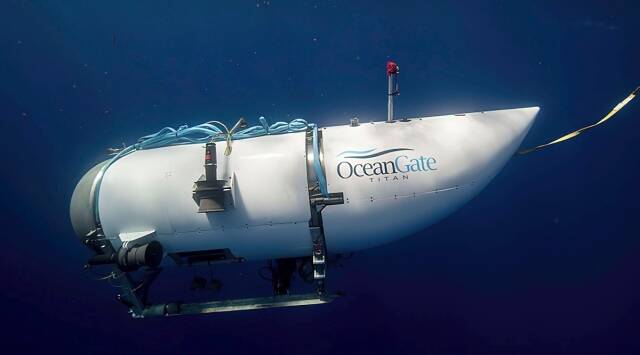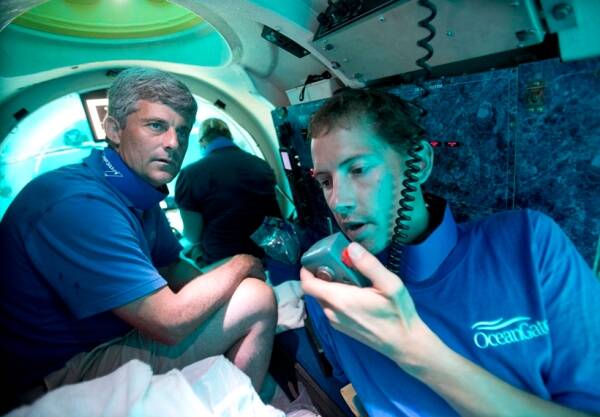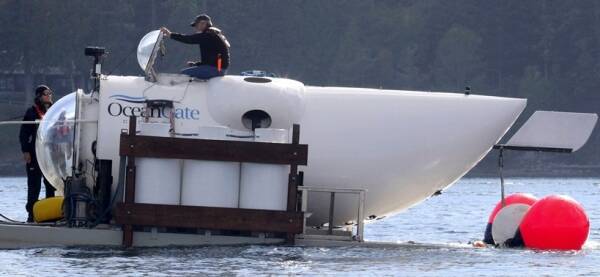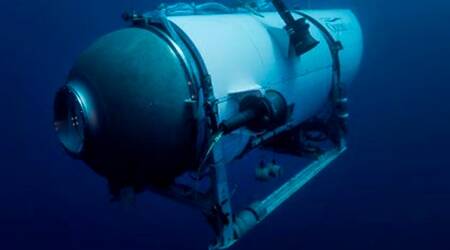Inside the Titan submersible: Quiet and cramped, with a single porthole
Mike Reiss, a producer and writer for “The Simpsons,” boarded the submersible vessel, known as the Titan, last summer. He said passengers were required to sign a waiver that mentioned death three times on the first page.
 This photo shows a submersible vessel named Titan used to visit the wreckage site of the Titanic. (OceanGate Expeditions via AP)
This photo shows a submersible vessel named Titan used to visit the wreckage site of the Titanic. (OceanGate Expeditions via AP) Written by Anushka Patil and Jacey Fortin
Passengers seeking a glimpse of the RMS Titanic aboard the submersible that disappeared in the North Atlantic this week have endured hours in a dangerous drop to the ocean floor aboard a cramped craft with a single porthole.
 Submersible pilot Randy Holt, right, communicates with the support boat as he and Stockton Rush, left, CEO and Co-Founder of OceanGate, dive in the company’s submersible, “Antipodes,” about three miles off the coast of Fort Lauderdale, Florida, June 28, 2013. (AP, file)
Submersible pilot Randy Holt, right, communicates with the support boat as he and Stockton Rush, left, CEO and Co-Founder of OceanGate, dive in the company’s submersible, “Antipodes,” about three miles off the coast of Fort Lauderdale, Florida, June 28, 2013. (AP, file)
Mike Reiss, a producer and writer for “The Simpsons,” boarded the vessel, known as the Titan, last summer. He said passengers were required to sign a waiver that mentioned death three times on the first page.
Passengers on his 10-hour journey — a trip that can cost up to $250,000 — were composed but excited, he said. Sandwiches and water were available on the vessel, but he recalled being told that many passengers did not eat during the journey because of excitement, and that the rudimentary toilet on board had never been used.
OceanGate Expeditions, which operates the vessel, has described the trip on its website as a “thrilling and unique travel experience.” The company did not immediately respond to a request for more information on Tuesday.
The Titan is a tight fit. David Pogue, a CBS reporter and former New York Times tech columnist who has been on board, described the cylinder as “about the size of a minivan.”
Images from OceanGate show a vessel with an interior like a metal tube, where passengers can sit on the flat floor with their backs to the curved walls. There is some overhead lighting but no chairs, and little room to move or stand upright.
Still, Reiss, who had previously travelled with OceanGate Expeditions to see Hudson Canyon off the shores of New York City, described the journey to the Titanic as “very comfortable” and said he fell asleep during the quiet, dimly lit descent. “You just drop like a stone for two and a half hours,” he said.
 OceanGate CEO Stockton Rush emerges from the hatch atop the OceanGate submarine Cyclops 1 in the San Juan Islands, Washington, on Sept. 12, 2018. (Alan Berner/The Seattle Times via AP)
OceanGate CEO Stockton Rush emerges from the hatch atop the OceanGate submarine Cyclops 1 in the San Juan Islands, Washington, on Sept. 12, 2018. (Alan Berner/The Seattle Times via AP)
As the submersible made its way to the Titanic, Reiss said, it was carried off course by underwater currents. The compass was “acting very weird,” he recalled, and the team knew only that they were about 500 yards from where they should have been.
Still, the Titan, which could spend only three hours on the ocean floor, managed to arrive at the wreck with roughly 20 minutes to spare for what Reiss called a quick “photo op.” He was able to see the sunken ship through the porthole, which he described as the size of a washing machine window.
The wreck was “the biggest thing in the world,” he said, “but you’re in such darkness, you just don’t know where it is going to be.”



































